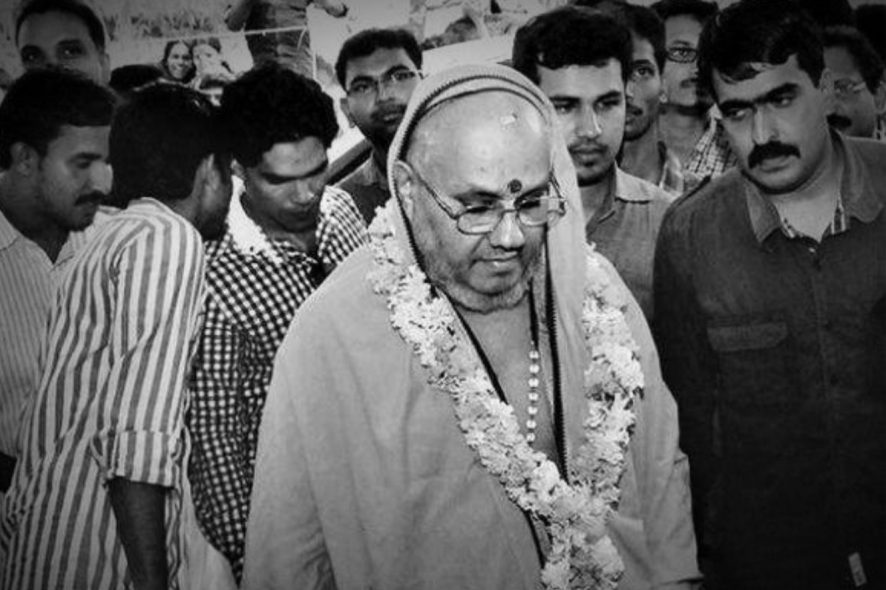His Holiness Kesavananda Bharati Sripadagalvaru, who initiated the case before the Supreme Court that gave us the ‘Basic Structure’ doctrine, passed away this morning at the age of 79 in his ashram at Edneer in north Kerala’s Kasaragod district.
His Holiness Kesavananda Bharati filed a petition on March 21, 1970, under Article 32 of the Constitution for enforcement of his fundamental rights under Articles 25, 26, 14, 19(1)(f) and 31 of the Constitution wherein he prayed that the provisions of the Kerala Land Reforms Act, 1963 (Act 1 of 1964) as amended by the Kerala Land Reforms (Amendment) Act, 1969 (Act 35 of 1969) be declared unconstitutional, ultra vires and void. The issues that started with challenge to 24th, 25th, 26th and 29th Amendments to the Constitution, went on to be heard by a Full Bench of 13 judges over seminal questions involving the limits on power of the Parliament to amend the Constitution.
After hearing the matter for almost 70 days, the 13-judge bench in Kesavananda Bharati v. State of Kerala, (1973) 4 SCC 225, wrote eleven judgments with nine judges writing individual judgments and Justices Shelat & Mukherjea and Justices Hegde and Grover teaming up to write combined judgments and held that the Parliament cannot alter the basic structure of the Constitution.
Here are some excerpts from the Judgment:
“Although it is permissible under the power of amendment to effect changes, howsoever important, and to adapt the system to the requirements of changing conditions, it is not permissible to touch the foundation or to alter the basic institutional pattern. The words “amendment of the Constitution” with all their wide sweep and amplitude cannot have the effect of destroying or abrogating the basic structure or framework of the Constitution.”
-Justice HR Khanna
“I am not interpreting an ordinary statute, but a Constitution which apart from setting up a machinery for Government, has a noble and grand vision. The vision was put in words in the preamble and carried out in part by conferring fundamental rights on the people.”
-Justice SM Sikri, Chief Justice of India
“Parts III and IV which embody the fundamental rights and directive principles of State policy have been described as the conscience of the Constitution. The legislative power distributed between the Union Parliament and the State Legislatures cannot be so exercised as to take away or abridge the fundamental rights contained in Part III.”
-Justices JM Shelat and AN Grover
“Our Constitution is not a mere political document. It is essentially a social document. It is based on a social philosophy and every social philosophy like every religion has two main features, namely, basic and circumstantial. The former remains constant but the latter is subject to change.”
-Justices KS Hegde and AK Mukherjea
“One cannot lift parts of the Constitution above it by ascribing ultra-constitutional virtues to them. The Constitution is a legal document and if it says that the whole of it is amendable, we cannot place the fundamental rights out of bounds of the amending power.”
-Justice DG Palekar
“Parliament cannot under Article 368 abrogate, damage or destroy, any of the fundamental rights though it can abridge to an extent where it does not amount to abrogation, damage or destruction.”
-Justice P. Jaganmohan Reddy
“If the State fails to create conditions in which the fundamental freedoms could be enjoyed by all, the freedom of the few will be at the mercy of the many and then all freedoms will vanish. In order, therefore, to preserve their freedom, the privileged few must part with a portion of it.”
-Justice YV Chandrachud
“… a Constitution is always valid whereas a law is valid only if it is in conformity with the Constitution … Just as an ordinary law derives its validity from its conformity with the Constitution, so also, an amendment of the Constitution derives its validity from the Constitution. An amendment of the Constitution can be ultra vires just as an ordinary law can be.”
-Justice KK Mathew
“… the good of the mass of citizens of our country is the supreme law embodied in our Constitution prefaced as it is by the Preamble or the “key” which puts “justice, social, economic and political” as the first of the four objectives of the Constitution by means of which “the people” of India constituted “a Sovereign Democratic Republic”.”
-Justice MH Beg
“Article 368 places no express limits on the amending power. Indeed, it expressly provides for its own amendment. Parliament and more than half of the States may jointly repeal Article 368 and thus make fundamental rights immutable if they so desire. It is not permissible to enlarge constructively the limitations on the amending power. Courts are not free to declare an amendment void because in their opinion it is opposed to the spirit supposed to pervade the Constitution but not expressed in words.”
-Justice SN Dwivedi
“Where the people express themselves in careful and measured terms in framing the Constitution and they leave as little as possible to implications, amendments or changes in the existing order or conditions cannot be left to inserting implications by reference to the Preamble which is an expression of the intention at the time of the framing of the Constitution. Therefore, the power to amend the Constitution is not restricted and controlled by the Preamble.”
-Justice AN Ray






